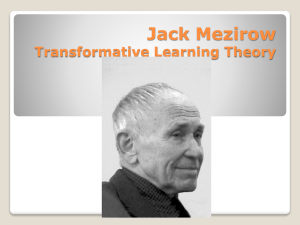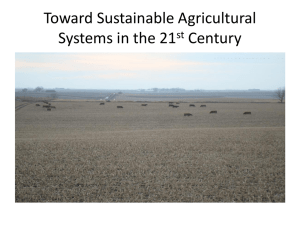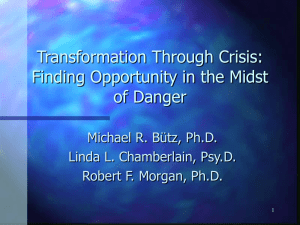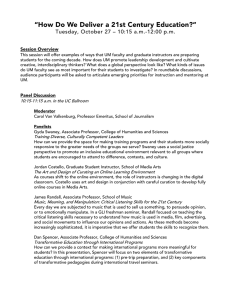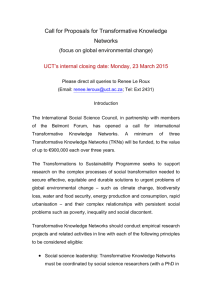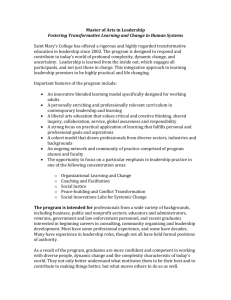Transformative Curriculum Leadership For Rural Ecologies Mediterranean Journal of Social Sciences
advertisement
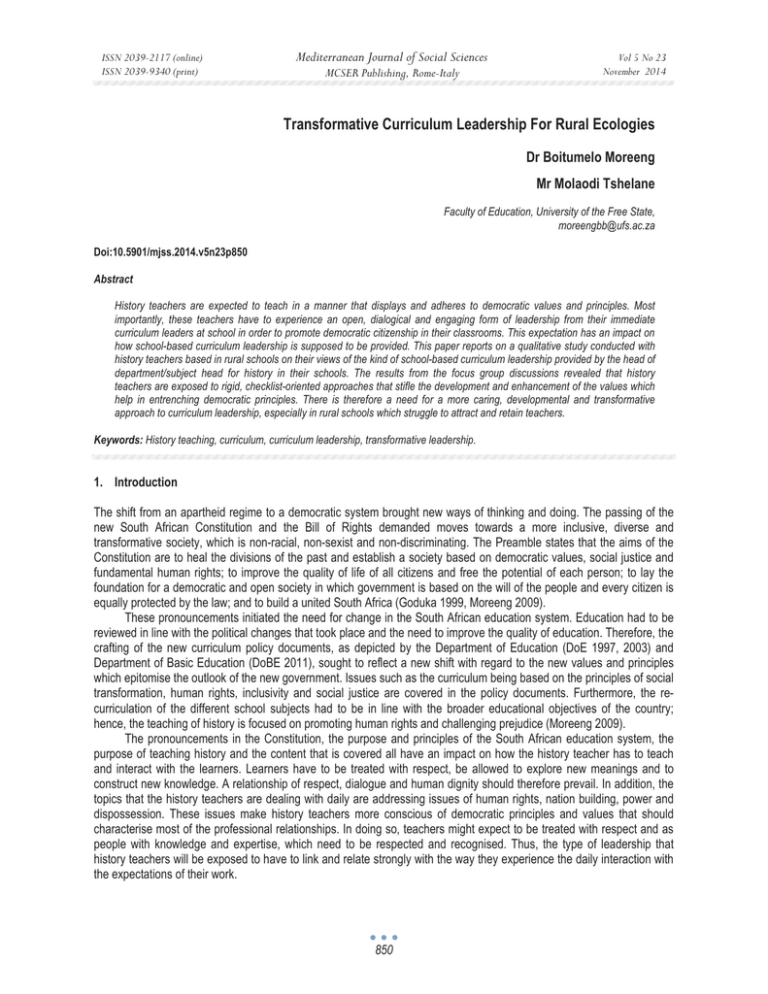
ISSN 2039-2117 (online) ISSN 2039-9340 (print) Mediterranean Journal of Social Sciences MCSER Publishing, Rome-Italy Vol 5 No 23 November 2014 Transformative Curriculum Leadership For Rural Ecologies Dr Boitumelo Moreeng Mr Molaodi Tshelane Faculty of Education, University of the Free State, moreengbb@ufs.ac.za Doi:10.5901/mjss.2014.v5n23p850 Abstract History teachers are expected to teach in a manner that displays and adheres to democratic values and principles. Most importantly, these teachers have to experience an open, dialogical and engaging form of leadership from their immediate curriculum leaders at school in order to promote democratic citizenship in their classrooms. This expectation has an impact on how school-based curriculum leadership is supposed to be provided. This paper reports on a qualitative study conducted with history teachers based in rural schools on their views of the kind of school-based curriculum leadership provided by the head of department/subject head for history in their schools. The results from the focus group discussions revealed that history teachers are exposed to rigid, checklist-oriented approaches that stifle the development and enhancement of the values which help in entrenching democratic principles. There is therefore a need for a more caring, developmental and transformative approach to curriculum leadership, especially in rural schools which struggle to attract and retain teachers. Keywords: History teaching, curriculum, curriculum leadership, transformative leadership. 1. Introduction The shift from an apartheid regime to a democratic system brought new ways of thinking and doing. The passing of the new South African Constitution and the Bill of Rights demanded moves towards a more inclusive, diverse and transformative society, which is non-racial, non-sexist and non-discriminating. The Preamble states that the aims of the Constitution are to heal the divisions of the past and establish a society based on democratic values, social justice and fundamental human rights; to improve the quality of life of all citizens and free the potential of each person; to lay the foundation for a democratic and open society in which government is based on the will of the people and every citizen is equally protected by the law; and to build a united South Africa (Goduka 1999, Moreeng 2009). These pronouncements initiated the need for change in the South African education system. Education had to be reviewed in line with the political changes that took place and the need to improve the quality of education. Therefore, the crafting of the new curriculum policy documents, as depicted by the Department of Education (DoE 1997, 2003) and Department of Basic Education (DoBE 2011), sought to reflect a new shift with regard to the new values and principles which epitomise the outlook of the new government. Issues such as the curriculum being based on the principles of social transformation, human rights, inclusivity and social justice are covered in the policy documents. Furthermore, the recurriculation of the different school subjects had to be in line with the broader educational objectives of the country; hence, the teaching of history is focused on promoting human rights and challenging prejudice (Moreeng 2009). The pronouncements in the Constitution, the purpose and principles of the South African education system, the purpose of teaching history and the content that is covered all have an impact on how the history teacher has to teach and interact with the learners. Learners have to be treated with respect, be allowed to explore new meanings and to construct new knowledge. A relationship of respect, dialogue and human dignity should therefore prevail. In addition, the topics that the history teachers are dealing with daily are addressing issues of human rights, nation building, power and dispossession. These issues make history teachers more conscious of democratic principles and values that should characterise most of the professional relationships. In doing so, teachers might expect to be treated with respect and as people with knowledge and expertise, which need to be respected and recognised. Thus, the type of leadership that history teachers will be exposed to have to link and relate strongly with the way they experience the daily interaction with the expectations of their work. 850 ISSN 2039-2117 (online) ISSN 2039-9340 (print) Mediterranean Journal of Social Sciences MCSER Publishing, Rome-Italy Vol 5 No 23 November 2014 2. Transformative Curriculum Leadership as a Theoretical Framework Due to the changes to the political landscape in South Africa, the way in which educational leadership was conceptualised also changed. This was further enhanced by what Makhwathana (2007) refers to as the rapid change in knowledge, including the knowledge of what is leadership and how it should be provided. Therefore, the move towards C2005 was seen as a key initiative in the transformation of South African society (Botha 2006). Whereas colonialism and apartheid emphasised the use of centralised and authoritarian control (Grant and Singh 2009), the DoE (1997) challenged schools to change from their traditional top-down approach to the participatory approach. Also, leaders in schools were expected to be agents of change and to contribute towards social transformation. To do this, they had to mirror the change in society which was needed to replace the authoritarian, rigid, top-down, hierarchical, controlling culture of education and the undemocratic way of societal and educational structure encouraged by apartheid with a culture characterised by participation, transparency and flatter structures. Leaders are also expected to be flexible towards societal context which leads to the evolution of leadership approaches that de-emphasise the individual and stress group or team leadership (DoE 1997; Van der Mescht and Tyala 2008). In this regard, Ndou (2008), supported by Yeung (2010), sees the provision of the type of leadership practice which is aligned as closely as possible with broader national intentions as the responsibility of the School Management Team (SMT). The DoE (1997) had realised that bureaucratic monitoring could hardly foster the real change which was required within the democratic dispensation and therefore pronounced that leadership and management are not the sole responsibility of the principal. This stance was grounded in a leadership theory which had moved consistently and progressively from the notion of a single heroic leader (Van der Mescht and Tyala 2008). 2.1 Transformative leadership The concept ‘leadership’ is complex and evolving. Most of what is written about leadership draws on western culture. However, leadership is likely to be viewed differently by different cultures, as it is not separable from the social and organisational context and conditions in which it operates (Coleman 2003; Grant et al. 2010; Dimmock 2012). This is how we approach the concept ‘leadership’ in this article, especially within the South African context, which is dynamic and in a constantly changing state of evolvement into a democratic society. Quinn (2007) and Penceliah (2011) view leadership as describing the wide range of structural and dynamic relationships between the leader and the followers. The main aim of the relationship, according to Van Niekerk and Dube (2011), is to influence people and to lead them towards goal achievement that usually results in a changed structure of the behaviour of groups, organisations or communities. Leadership is further seen as a social process inextricably connected to moral and ethical values in a social context, which therefore has an impact on the kind of virtues that must underlie the process (Shields 2004; Quinn 2007; Penceliah 2011). The above conceptualisation points to the fact that leadership is a function that one performs and not the position that one holds. Thus, where leaders were traditionally successful because they possessed certain skills, according to the bureaucratic-managerial model and the transactional models which were goal-driven by production measurements, currently the focus falls on the actions that the leader displays in providing the transformational and transformative type of leadership (Quinn 2007). In support of the latter view, Astin and Astin (2000) and Preece (2003) add that leadership is about empowerment, sharing power and accepting the power people have by enhancing equity, social justice and respect. Therefore, transformative leadership seems to be the type of leadership that would function well in the everchanging and dynamic organisational structures. Barett (2012), in assisting to locate and identify transformative leaderships, opines that the theory of transformative leadership is grounded in a critical theoretical perspective which seeks to challenge and change traditional school practices by means of empowering followers to become leaders in the school community. MacDonald (2007 further adds that the objective of critical theory is to understand the underlying social structures of society – in order to find solutions for the eradication of domination and oppression – by allowing conversations and deliberations based on the principles of respect and equality. Therefore, studies of leadership that utilise a critical framework focus on power dynamics to explore instances of exploitation and abuses of power in relationships. The basis of transformative leadership is the recognition and challenge of the material and social realities which foster inequality and marginalisation. Transformative leadership assumes an oppositional stance towards the hegemonic forms of school leadership (Dantley 2002) by challenging the inappropriate use of power and privilege which creates or perpetuates inequality and injustice. In this regard, transformative leadership calls for a new approach to leadership that is empowering, collaborative and inclusive (Shields 2009). The combination of descriptions in the above literature creates 851 ISSN 2039-2117 (online) ISSN 2039-9340 (print) Mediterranean Journal of Social Sciences MCSER Publishing, Rome-Italy Vol 5 No 23 November 2014 an image of the transformative leader as one who is committed to a process of nurturing change but in a context-sensitive way. The drive for change comes from an inner belief, an inspiration, which is connected to awareness, vision and empowerment (Preece 2003). In evolving towards a transformative leader, Apps (1994) suggests four stages through which the leader will have to go. These stages are not necessarily linear. They are, firstly, awareness analysis – a point of realisation that something is wrong; secondly, alternatives – a stage where one is aware of the context of reality and looking at a variety of approaches to leading. The third stage is referred to as the decision transition – where fundamental shifts in beliefs and values are made. This stage is sometimes seen as a spiritual experience – a reaffirmation of some old beliefs, values and ideas; acceptance and integration of new ones, discarding obsolete ones. The importance of this stage is reiterated by Keeney (2010) when using the concept of shaking as one of the metaphors of the n/om-kxaosi San emphasising transformative leadership. Other authors, for example, Shields (2009) and Barrett (2012), use words such as breakdown, rebuild, disruptive education, disruption and deconstruction to explain what happens during this stage. The fourth step by Apps addresses the need for action. It is at this stage that new ideas are carried out through a process of action and reflection, accepting the uncertain future (Apps 1994, Preece 2003). Leadership in a transformative mode is therefore not a position but a way of being. It is fleeting and transient and also functional in that it is present when it is being exercised. The leader is somewhat de-centred since teachers are viewed and treated as people with knowledge and expertise who are therefore capable actors. This view of teacher leadership is a radical departure from the traditional understanding of school leadership because it deconstructs the notion of leadership in relation to position in the organisation. Instead, it constructs leadership as a process which is shared and which involves working with all stakeholders in a collegial and creative way to seek out the untapped leadership potential of people and develop this potential within a supportive environment for the betterment of the school (Grant 2009). Transformative leadership makes for a stronger case because it articulates the idea of power through people instead of power over them (McGregor 2004). Transformative leaders build a connecting sense of trust in their followers. This enables the followers to take a leap into the unknown by applying what is referred to as relational trust, which is seen as a precondition for success (Kaser and Halbert 2009, Day et al. 2011). This building of trust is done in addition to the care-giving responsibilities in order to make members feel safe (Quinn 2007). Creating these types of relationships makes up the basic fabric of human life and must not be pushed to the periphery of leadership considerations (Preece 2003), especially in the rural areas. Furthermore, Shields (2009) asserts that the transformative leader is to create learning contexts or communities in which social, political and cultural capital is enhanced in such a way as to provide equal opportunities for all stakeholders and opportunities to create leaders among their followers. Nell (2009) refers to this communal operation as tapping into the social capital, as it encourages collaboration with the aim to achieve mutual benefits. Transformative leaders are less concerned with exchanges than with changing beliefs and values, they do not focus on providing rewards for performance, instead they attempt to build ownership on the part of others by involving them in the process (McGregor 2004). This concurs with what Dantley (2002) refers to as enacting an agenda of reform and reconstruction. Jahan (2000) further identifies leadership elements such as guiding, directing and influencing others to bring about fundamental change – not only of the external world, but also of internal processes – as being of value to the transformative process. Adding to the discussion, Jahan (2000) argues that transformative leaders are not necessarily driven by simple efficiency considerations; instead they value sustainability above growth. They display commitment towards the principles of sharing power, responsibility and well-being and, consequently, consultation and democratic participation are part of their institutional culture. They are further willing to distribute leadership as far as possible (Grant 2009, Grant et al. 2010) and apply open and transparent decision-making processes. By so doing, transformative leadership has the potential to establish communities of hope, as envisaged by Paulo Freire. Transformative leadership seems to be even more appropriate for teachers in rural schools, as they are constantly exposed to poor working conditions, low socio-economic conditions and limited resources (DoBE 2011; Ebersöhn and Ferreira 2012; UNESCO 2005). This environment has a tendency to influence the way in which teachers define themselves, in this case, as rural teachers (Pillay and Saloojee 2012). The schools in the rural areas struggle to attract and retain teachers in spite of attempts to address issues such as resources, multi-grade teaching and teacher training (DoBE 2011). Less attention seems to be paid to changing the leadership practices in the rural areas to become more humane and accommodating so that teachers in these areas can be made to feel more appreciated. In this regard, Mahlomaholo (2012) and Hlalele (2011, 2012) warn against the focus on issues of rural education from a deficit perspective, which should shift to an asset-based perspective that seeks to explore the richness of teachers’ potential. Hlalele (2012) elaborates that the knowledge and expertise of rural teachers should be acknowledged 852 ISSN 2039-2117 (online) ISSN 2039-9340 (print) Mediterranean Journal of Social Sciences MCSER Publishing, Rome-Italy Vol 5 No 23 November 2014 and enhanced. Therefore, approaching leadership in the rural schools from a transformative perspective might help in cushioning some of the difficulties experienced by the teachers in these schools. The focus of this paper is thus to establish the extent to which history teachers in the rural areas are exposed to transformative leadership practices in their schools. 3. Research Methodology The study sought to explore and describe the way in which history teachers perceive and experience curriculum leadership by investigating their views, feelings and experiences about curriculum leadership in their schools, while avoiding judgment of the nature of the experiences and feelings expressed. Exploratory research is a way of finding out what is happening, seeking new insights, asking questions and assessing phenomena in a new light. Descriptive of educators’ experiences, the interpretative paradigm does not concern itself with the search for broadly applicable laws and rules, but rather seeks to produce descriptive analysis which emphasises deep, interpretive understanding of social phenomena (Fouche and De Vos 2005). The methodology involved focus group discussion conducted with a group of twelve history teachers from eight rural schools in one education district in the Free State Province. All the participants were teaching history in Grade 10 to 12. I visited the individual schools and held meetings with the teachers to share the purpose of my research and to obtain their consent for participation in the study. Thereafter we agreed on a date for the focus group discussion where all twelve teachers were to be present. The interviews were conducted after school in the local community centre, as this was central and accessible to all the participants. Five of the participants were female and the remaining seven were male. All of the participants have been working in their respective schools for over five years. The participants’ real names have been replaced by fictitious initials. The discussions were initiated by asking the following broad and open-ended question: “How is curriculum leadership provided in your school?” “How do you experience curriculum leadership in your school?” “How do you want curriculum leadership to be structured in your school?” “What views do you have about the way curriculum leadership is provided in your school?” Follow-up questions were posed in order to further understand the responses or to seek clarity on the responses. Permission was requested from the participants to record the conversation and to also take some notes in the process. The interview lasted for about one hour and thirty minutes. Data were analysed by means of qualitative content analysis. Codes were generated from the data and continuously modified. Further analysis was done to identify data that related to the key concepts in the research questions, theoretical frameworks and the literature review. Multiple readings of data were conducted, organising the codes and themes into higher levels of categories within and across the interviews. In doing this the following were identified and described, pre-set codes, , pre-set categories, patterns and themes relevant to the research questions were identified during the literature review. Analysis became an iterative process where initial impressions from the interviews were checked against the data (Cohen, Manion and Morrison 2011). 3.1 Finding and discussions Findings emanating from data analysis suggest that history teachers in the rural areas are still exposed to the forms of curriculum leadership that are not using and adhering to the principles of transformative leadership. Instead, they are exposed to curriculum leadership that is undemocratic and not inclusive. The data are presented in the following paragraphs under the three issues of curriculum leadership and management; curriculum goal setting and planning; and school-based curriculum interpretation. 3.1.1 Curriculum leadership and management Leadership pertains more to actions that are performed than positions that are occupied. It is only when leaders perform their leadership function that others will experience the type of leadership that is being used. It was therefore necessary to establish how the participants experience the way in which leadership is provided in their schools. It was, in fact, fascinating to see how teachers from the different schools had a similar experience of leadership from their principals and the SMT. Mr TK, from one of the schools, had this to say: 853 ISSN 2039-2117 (online) ISSN 2039-9340 (print) Mediterranean Journal of Social Sciences MCSER Publishing, Rome-Italy Vol 5 No 23 November 2014 For me leadership is the responsibility of the principal and the SMT. They plan all the activities for the school, monitor and check whether we are doing what we are supposed to do. I do not think a school can function well without them. This view was echoed by Ms N, who came from a school of 15 teachers, four of whom formed the SMT: Curriculum leadership is seen when my principal provide leadership by informing the rest of the staff about matters relating to the curriculum. The principal makes sure that we have the policy documents, the work schedule and all matters needed in order to teach. There seems to be two striking issues emanating from these responses, namely that participants are experiencing curriculum leadership as the responsibility of the principal and the SMT by virtue of their structural or organisational position, who display a rigid and hierarchically based order of curriculum leadership. Furthermore, there seems to be little or no recognition of the teachers’ experience and expertise, despite the education system having undergone a number of changes that called for the use of much more inclusive and participatory leadership practices (Van der Mescht and Tyala 2008; Grant et al. 2010). This issue is further strengthened by Mafora (2013), who calls for a transformative leadership that has to change the conditions of inequality and marginalisation in the schools in order to create a more socially just and democratic atmosphere. Secondly, it appears as if the principal and the SMT form a structure with power that they have to use so that it can be felt by the teachers. Within a transformative discourse, structures are not supposed to reinforce power and dominance but should, instead, give people the space to perform their tasks effectively. The function of the structure is to serve and support the people (Shields 2009). The fact that teachers experience them as doing all the planning, monitoring, checking, informing them on what and how to do things, might show some sense of power that they are seen to possess. They are further projected as people who are monopolising knowledge of quality and, since they are perceived to be knowing everything, they can check and comment on the teachers quality of the work. Teachers, on the other hand, seem to subject themselves to be on the receiving end of this kind of approach because they view themselves in the words of Mr KG: ... being post level teachers, we are juniors and are supposed to be led by the SMT. The situation is exacerbated by the experience from Mr TY and Ms K respectively: My file is usually presented once every fortnight by my HoD. A checklist is used to check my work, ticks are used to establish what is in my file and what is not there. I do not get to discuss my work with my HoD or even the principal who sometimes also check our files. One would really love to have a discussion about his work. ... feel it is like routine check of the work which is not developmental. The view of Mr KG, supported by those of Mr TY and Ms K, seems to contradict the proposed shift in leadership from a single, heroic leader to the one which stresses the groups or team leadership (Van der Mescht and Tyala 2008). This might result in the participants’ displaying feelings of, what Wineman (2003) refers to, as internalised powerlessness such as despair, hopelessness and thinking that change is impossible since the principal is single-handedly projected as leading the school to greatness (Spillane 2005). These feelings can be ascribed to the fact that the teachers have been exposed to this situation for an extended period and thus think this is the way things are supposed to be. This is a limited view of looking at the curriculum because it emphasises the SMT’s control over teachers. They seem not to have a say in what is happening in class. This view evidently contradicts the principles of transformative leadership as espoused by Law, Galton and Wan (2007), namely that curriculum leadership should call for a change in how the SMT create a collegial, dialogic and free environment through, among others, meaningful delegation, with the aim to promote growth in teacher performance and student learning. The theme of the need to build a collaborative culture in the school came out very strongly during the conversations. Collaboration has been acknowledged as one of the principles for transformative leadership. Shields (2004), supported by Marzano, Waters and McNulty (2005), views a collaborative culture as one that offers all legitimate stakeholders the opportunity to participate and make them feel comfortable and empowered, thereby developing their competency and capability. This process is usually established through the building of lasting professional relationships, showing individual support and commitment, and understanding the wider contextual factors (Gurr, Drysdale and Mulford 2007). Some of the benefits of encouraging collegial collaboration is that more perspectives are represented and that it allows for the use of different personal and professional strengths. Through collaboration, more informed decisions are reached and, most importantly, especially for rural schools, a strong sense of loyalty to the school might be established. 854 ISSN 2039-2117 (online) ISSN 2039-9340 (print) Mediterranean Journal of Social Sciences MCSER Publishing, Rome-Italy Vol 5 No 23 November 2014 This loyalty can go a long way in cushioning the already difficult and challenging conditions that the teachers are exposed to in the rural areas (Singh 2012; Spillane 2005; De Villiers and Pretorius 2011). 3.1.2 Curriculum goal-setting and planning Participants were further asked to reflect on how planning and the setting of goals for curriculum implementation are conducted in their different schools. This response by Mr JJ seems to summarise the views of most of the participants when declaring that: The school management team is very rigid, especially with the way they approach the curriculum implementation. This unquestionable adherence to the use and following of the syllabus is not good. It does not allow for flexibility in terms of how I cover the content in class. If it is March and I have to be on Chapter 3 my HoD is expecting exactly that and they do not want to understand how I had to follow a certain order in order to respond to the needs and abilities of my learners. The above response was supported by Ms D, who also claimed exclusion from decision-making processes: Most of the work is done by the SMT. They sit, plan and come up with a plan. By the time they come to us it is already an agreed document. We have little contribution to make in that regard. Sometimes the plan is received from the department of education and as schools we just have to adhere to it. In both of the above responses, follow-up questions sought to establish the teachers’ feelings about being excluded and not consulted in matters of school-based curriculum planning and implementation. Participants indicated their dissatisfaction in this regard, as depicted in this response by Mrs O: I do not really feel like I am in charge of my subject, my decisions are always questioned, I am made to feel I don’t know what I am doing. My leader is too rigid and only wants us to do things his way. That limits my potential and in fact undermines my professionalism. As Mrs O was expressing the above view, the rest of the group were nodding and using interjections to show agreement. Thus, not being included in the decision-making processes, especially those that have an impact on the teachers’ activities in class, was experienced negatively by the participants. The teachers appeared to be in desperate want of leadership that will, in the terms of Grant et al. (2010), Naicker and Mestry (2011), be more shared, consultative, collaborative and participatory and further recognise their expertise and knowledge, which will result in deep democratic involvement in leadership practice and collective capacity building of all involved (De Villiers and Pretorious 2011). This approach to school-based curriculum planning and implementation will therefore shift attention from the what of leadership structures and functions to the how of curriculum leadership (Spillane 2005). Responses from the participants also indicated that the lack of this collaborative planning culture in a school also has an impact on how teachers in the same school relate and interact, as indicated in the following response from Ms G: During subject meetings we do try to plan together as teachers in a particular phase but our plan is immediately compromised by the individual way of looking at our work. Mr BB concurred by stating that: This lack of planning is sometimes creating a feeling of animosity between the different teachers. Teachers in grade 12 always blame those in the lower grades when learners can perform. The fact that schools are operating as static organisations with structures and not like organic ones with dynamic patterns which allow for role changes in the group (Van der Mescht and Tyala 2008) is adding to the problems mentioned above. Teachers feel like they are not a part, or even that they cannot be a part, of the established fixed organisational structures. This approach further leaves teachers with little chance of being empowered, as future leaders should be exposed to more team-based and distributed approaches to leadership (Naicker and Mestry 2011). Evers and Katyal (2007) maintain that these inclusive forms of leadership have better chances of improving human relations, as people are constantly engaged in an on-going dialogue; hence, it is viewed as providing moral leadership. The potential conflicts and mistrust insinuated in the above responses by Ms G and Mr BB, and further emphasised here by Ms O, can be greatly 855 ISSN 2039-2117 (online) ISSN 2039-9340 (print) Mediterranean Journal of Social Sciences MCSER Publishing, Rome-Italy Vol 5 No 23 November 2014 minimised: ... as teachers in the same subject we don’t know what is happening in other grades that we are not teaching. The exclusion and non-involvement of teachers in the planning process is disadvantageous because, as Singh (2012) rightfully purports, teaching and learning are knowledge-intensive activities which thrive on the knowledge and wisdom of the collective. Over-reliance on one person or a fixed structure will therefore limit potential powerful and creative input needed to move schools forward quickly and effectively. 3.1.3 School-based curriculum interpretation Following the issue of curriculum goal setting and planning, was the need to explore how teachers experience the way in which curriculum is interpreted in their schools. This is a critical issue, since it has an impact on what is supposed to occur in their classrooms. The views from the participants indicate that interpretation of the curriculum is a somewhat centralised and rigid process in which they do not have a say. Mr KO had this to say: I do not think enough platforms are created to allow for teachers in schools to discuss what the curriculum means to them and the implications on how it is supposed to be taught in class. The above view is supported by Ms D, who views it as: ... uncritical adherence to curriculum policy interpretation by the departmental officials – hence designed work schedules, assessment tasks, common tests/examination papers without taking into consideration our rural context. The views of Mr KO and Ms D further added to the feeling of exclusion, from their own experiences. Thus, instead of creating platforms in the schools to allow for more localised meaning making and interpretation of the curriculum, teachers have adopted a one-size-fits-all approach. Law, Galton and Wan’s (2007) argument for a decentralised way of making meaning about what to teach, how to teach and how to assess is therefore supported, as this will accommodate teachers’ views and feelings about the processes. Collective organisational responsibility displayed through cooperation and collaboration (De Villiers and Pretorius 2011; Marishane and Botha 2011) might be enhanced, resulting in a positive impact on the school culture and environment, which is needed mostly in rural setups. The need and value for localised interpretation and meaning making of the curriculum is further illuminated by Mr PP when indicating that: Yes, we do go for cluster meetings with other schools in our area but ultimately it is what happens in the classroom that really matters, but in these meetings people seem to only think of schools in town. Mr PP seemed to be looking for an opportunity to, when returning to his school from these meetings, be able to apply that which was discussed during the workshop in his context and to make suggestions. Transformative leadership will be meaningful in this regard because it will have space for Mr PP to discuss his views and concerns, to seek for help from other teachers and to modify the curriculum according to his expertise for the greater benefit of his school (Van der Mescht and Tyala 2008). In turn, Mr PP might feel respected, acknowledged and affirmed in his school (Spillane 2005). Mr PP went further by commenting on the need for flexibility in curriculum leadership to avoid, what he viewed as: ... pursuing of poor quality quantitative results achieved through technocratic procedures of drilling, cut and paste and repetition, use of rigid check lists and monitoring tools. 4. Conclusion and Recommendations The findings of this study suggest that history teachers in the rural schools, which participated in this study, experience curriculum leadership that is a rigid structural and organisational position, with little consideration of the needs and abilities of the teachers. As a result of this undemocratic leadership, participants have a feeling of being neglected and not being acknowledged. The principals and the SMT of the different schools are still dominating the processes of schoolbased curriculum interpretation and planning. Consequently, teachers, once again, experience a sense of neglect and not being appreciated by the principals and the SMTs. These strong feelings of neglect might play a significant part in the challenge to retain teachers in the rural areas where there is a need to create a climate which fosters a sense of 856 ISSN 2039-2117 (online) ISSN 2039-9340 (print) Mediterranean Journal of Social Sciences MCSER Publishing, Rome-Italy Vol 5 No 23 November 2014 belonging among teachers (Theoharis 2010). A study by Grant and Singh (2009) also concluded that, despite an enabling democratic policy framework, leadership of many South African schools remains entrenched in formal, hierarchical management structures. There is therefore a need for SMTs, especially those in the rural schools, to be assisted in gaining better understanding of transformative leadership as a way of broadening and using inclusive approaches to leadership. As teachers will ultimately be included in the process of leadership, they, too, must be exposed to the principles of transformative leadership. Thus, instead of focusing only on teachers as curriculum implementers, they should be exposed to the participative and distributed forms of curriculum leadership. Teachers exposed to this kind of leadership will feel acknowledged and respected, and will be treated as knowledgeable and capable actors (Bennett and Anderson 2003). When teachers are recognised and affirmed in this manner, they feel more like a part of their schools. The working environment might become more welcoming and teachers might be retained longer. References Apps, J.W. (1994). Leadership for the Emerging Age. San Francisco, Jossey Bass. Astin, A.W., & Astin, H.S. (2000). Leadership reconsidered: Engaging higher education in Social change [online] Available: http://www.wkkf.org/pubs/CCT/leadership/pub3368 PDF(retrieved, February 13, 2013). Barrett, A.J. (2012). Transformative leadership and the purpose of schooling in affluent communities. Unpublished Dissertation. Illinois, University of Illinois. Bennett, N., & Anderson, L. (2003). Rethinking Educational Leadership. Challenging the Conventions. London, Sage. Botha, N. (2006). Leadership in school-based management: A case study in selected schools. South African Journal of Education. 26(3), 341-353. Cohen, L., Manion, L., & Morrison, K. (2011). Research Methods in Education. 6th edition. London, Routledge Falmer. Coleman, M. (2003). Theories of leadership. In Thurlow M, Bush T, and Coleman M. 2003. Leadership and Strategic Management in South African Schools. Huddersfield. UK, Commonwealth Secretariat. Dantley, M. (2002). Transformative leadership and its intersection with Cornell West’s interpretation of prophetic spirituality. http://www.units.muohio.edu./eduleadership/faculty/Dantley/Documents/prophetic spirituality.pdf. Retrieved: 14 February 2013, Day, C., Sammons, P., Leithwood, K., Hopkins, D., Gu, Q., Brown, E., & Ahtaridou, E., (2011). Successful School Leadership. Linking Learning and Achievement. Berkshire. England: Open University Press. Department of Basic Education, (2011). South African Rural Educator. Vol 1. Pretoria, Department of Basic Education. Department of Education. (2003). National Curriculum Statement. Grade 10-12 General. History. Pretoria, Department of Education. Department of Education.(1997). White Paper on Education and Training. Pretoria, Department of Education. De Villiers, E., & Pretorius, S.G. (2011). Democracy in schools: Are educators ready for teacher leadership? South African Journal of Education. 31, 574-589. Dimmock, C. (2012). Leadership, Capacity Building and School Improvements. Concepts, Themes and Impact. London, Routledge. Ebersöhn, L., & Ferreira, R. (2012). Rurality and resilience in education: Place-based partnerships and agency to moderate time and space constraints. Perspectives in Education. 30(1),30-42. Evers, C., & Katyal, K. (2007). Paradoxes of leadership: Contingencies and critical learning. South African Journal of Education. 27(3): 377-390. Fouche, C.B., De Vos, A.S. (2005). Quantitative research design. In De Vos, A.S., Strydom, H., Fouche, C.B., Delport, C.S.L. Research at Grassroots for Social Sciences and Human Services Professions. 3rd Edition. Pretoria, Van Schaik. Goduka, M.I. (1999). Affirming Unity in Diversity in Education: Healing with Ubuntu. Cape Town, Juta. Grant, C.( 2009). Towards a conceptual understanding of education of education leadership: place, space and practices. Education as Change. 13(1), 45-57. Grant, C., & Singh, H. (2009). Passing the buck: This is not teacher leadership! Perspectives in Education. 27(3), 289-301. Grant, C., Gardner, K., Kajee, F., Moodley, R., & Somaroo, S. (2010). Teacher leadership: A survey analysis of KwaZulu-Natal teachers’ perceptions. South African Journal of Education. EASA. 30, 401-419. Gurr, D., Drysdale, L., & Mulford, B. (2007). Instructional Leadership in three Australian Schools. International Studies in Educational Administration. 35(3), 11-19. Hlalele, D.J. (2012). Social justice and rural education in South Africa. Perspectives in Education. 30(1), 111-117. Hlalele, D.J. (2011). Call for papers for the Free State University, Qwaqwa Campus Colloquium on Sustainable Learning Rural Ecologies for 24-26 November 2011. Retrieved on January 2013 from www.ufs.ac.za. Jahan, R. (2000). Transformative Leadership in the 21st Century. Paper presented at the Asia-Pacific Women Parliamentarians’ Conference on Transformative Leadership for Good Governance in the 21st Century. 24-25 March 2000, Bangkok. Kaser, L., & Halbert, J. (2009). Leadership Mindsets. Innovation and Learning in the Transformation of Schools. Abingdon. UK, Routledge. Keeney, B. (2010). N/om and transformative leadership. Considering the embodied know-how of the Kalahari Bushman N/om-Kxaosi. Revision. A Journal of Consciousness and Transformation. 30(3 & 4), 51-55. Law, E.H., Galton, M., & Wan, S.W. (2007). Developing curriculum leadership in schools: Hong Kong perspectives. Asia-Pacific Journal 857 ISSN 2039-2117 (online) ISSN 2039-9340 (print) Mediterranean Journal of Social Sciences MCSER Publishing, Rome-Italy Vol 5 No 23 November 2014 of Teacher Education. 35 (2),143-159. MacDonald, R.A., (2007). Human Rights and Social Justice. Montreal, Prepared for the Trudeau Fondation. Mafora, P., (2013). Transformative leadership for social justice: Perceptions and experiences of South African township secondary school principals. Journal of Social Sciences. 34(1), 37-45. Mahlomaholo, S.G., (2012). Early school leavers and sustainable learning environment in rural contexts. Perspectives in Education. 30(1), 101-110. Makhwathana, R.M., (2007). Effects of curriculum changes on primary schools educators at Vhumbedzi Circuit, Limpopo. Unpublished Dissertation. Pretoria, Tshwane University of Technology. Marishane, R.N., Botha, R.J., (2011). School Leadership in a Changing Context: A Case for School-Based Management. Pretoria, Van Schaik Publishers. Marzano, R., Waters, T., & McNulty, B.A., (2005). School leadership that works. From research to results. Virginia. USA, ASCD Moreeng, B.B., (2009). Structuring of a powerful learning environment for the teaching and learning of history in the Further Education and Training Band in Free State schools. Unpublished Thesis. Bloemfontein, University of the Free State. Naicker, S.R., & Mestry, R., (2011). Distributive leadership in public schools: Experiences and perceptions of teachers in the Soweto region. Perspective in Educations. 29(4), 99-108. Ndou, N.F., 2008. The role of school management teams in curriculum change management. Unpublished Dissertation. Pretoria: University of South Africa. Nell, I.A., (2009). Leaders lost in transition. A case study in leadership, ritual and social capital. Ned Geref Teologiese Tydskrif. 50(1 & 2), 160-170. Penceliah, Y., (2011). Leadership in a multicultural organizational context: Some perspectives. Africanus. 41(2), 46-59. Pillay, D., & Saloojee, S., (2012). Revisiting rurality and schooling: A teacher’s story. Perspectives in Education. 30(1), 43-58. Preece, J., (2003). Education for transformative leadership in Southern Africa. Journal of Transformative Leadership in Southern Africa. 1(3), 245-263. Quinn, K., (2007). Exploring departmental leadership: How department chairs can be transformative leaders. InterActions: UCLA Journal of Education and Information Studies. 3(1), Article 5. Shields, C.M., (2009). Transformative leadership: A call for difficult dialogue and courageous action in racial contexts. Journal for International Studies in Educational Administration. 37(3): 53-68. Shields, C. 2004. Dialogic leadership for social justice: Overcoming pathologies of silence. Educational Administration Quarterly. 40(1): 109-132. Singh, K., (2012). Preparing for the challenge of effectively distributing leadership: Lesson learned from the creation of a leadership team. Journal of Transformative Leadership and Policy Studies. 2(1), 35-48. Spillane, J.P., (2005). Distributed leadership. The Educational Forum. 69, 143-150. Theoharis, G., (2010). The school leaders our children deserve: Seven keys to equity, social justice and school reform. New York and London: Teachers College. UNESCO 2005. Country Report: South Africa. Ministerial seminar on Education for Rural People in Africa: Policy Lessons, Options and Priorities. Ethiopia, Addis Ababa, 7-9 September 2005. Paris: UNESCO. Van der Mescht, H., & Tyala, Z. (2008). School principal’s perceptions of team management: A multiple case study of secondary schools. South African Journal of Education. 28, 221-239. Van Niekerk, E., & Dube, W. (2011). The inadequate induction of novice educators: A leadership failure? Acta Academica. 43(3), 243265. Wineman S 2003. Power-Under Trauma and Nonviolent Social Change 2003. [online] Available www.TraumaAndNonviolence.com. Retrieved 9 April 2013. Yeung, S.S., (2010). Using school evaluation policy to effect curriculum change? A reflection on the SSE and ESR exercise in Hong Kong. Educational Research Journal. 25(2), 187-205. Reference to a journal publication: Van der Geer, J., Hanraads, J. A. J., & Lupton R. A. (2000). The art of writing a scientific article. Journal of Scientific Communications, 163, 51-59. 858

